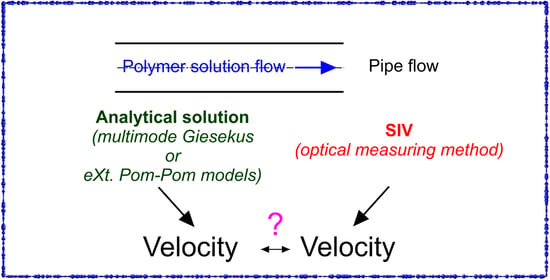Exact Solution for Viscoelastic Flow in Pipe and Experimental Validation
Abstract
:1. Introduction
2. Problem Statement
2.1. Mathematical Model
2.2. Parametric Method
3. Materials and Methods
3.1. Experimental Setup
3.2. Visualization
3.3. Polymer Solution Preparation
3.4. Rheological Measurements
4. Results and Discussion
5. Conclusions
Author Contributions
Funding
Institutional Review Board Statement
Informed Consent Statement
Data Availability Statement
Conflicts of Interest
References
- Cruz, D.O.A.; Pinho, F.T. Skewed Poiseuille-Couette Flows of sPTT Fluids in Concentric Annuli and Channels. J. Non-Newt. Fluid Mech. 2004, 121, 1–14. [Google Scholar] [CrossRef]
- Cruz, D.O.A.; Pinho, F.T.; Oliveira, P.J. Analytical solutions for fully developed laminar flow of some viscoelastic liquids with a Newtonian solvent contribution. J. Non-Newt. Fluid Mech. 2005, 132, 28–35. [Google Scholar] [CrossRef] [Green Version]
- Oliveira, P.J. An exact solution for tube and slit flow of a FENE-P fluid. Acta Mech. 2002, 158, 157–167. [Google Scholar] [CrossRef] [Green Version]
- Schleiniger, G.; Weinacht, R.J. Steady Poiseuille flows for a Giesekus fluid. J. Non-Newt. Fluid Mech. 1991, 40, 79–102. [Google Scholar] [CrossRef]
- Oliveira, P.J.; Coelho, P.M.; Pinho, F.T. The Graetz problem with viscous dissipation for FENE-P fluids. J. Non-Newt. Fluid Mech. 2004, 121, 69–72. [Google Scholar] [CrossRef]
- Coelho, P.M.; Pinho, F.T.; Oliveira, P.J. Thermal entry flow for a viscoelastic fluid: The Graetz problem for the PTT model. Int. J. Heat Mass Transf. 2003, 46, 3865–3880. [Google Scholar] [CrossRef]
- Coelho, P.M.; Pinho, F.T.; Oliveira, P.J. Fully-developed forced convection of the Phan-Thien-Tanner fluid in ducts with a constant wall temperature. Int. J. Heat Mass Transf. 2002, 45, 1413–1423. [Google Scholar] [CrossRef] [Green Version]
- Oliveira, P.J.; Pinho, F.T. Analysis of forced convection in pipes and channels with the simplified Phan-Thien-Tanner fluid. Int. J. Heat Mass Transf. 2000, 43, 2273–2287. [Google Scholar] [CrossRef] [Green Version]
- Hashemabadi, S.H.; Etemad, S.G.; Thibault, J.; Golkar-Naranji, M.R. Analytical solution for dynamic pressurization of viscoelastic fluids. Int. J. Heat Fluid Flow 2003, 24, 137–144. [Google Scholar] [CrossRef]
- Hashemabadi, S.H.; Etemad, S.G.; Thibault, J.; Golkar-Naranji, M.R. Mathematical modeling of laminar forced convection of simplified Phan-Thien-Tanner (SPTT) fluid between moving parallel plates. Int. Com. Heat Mass Transf. 2003, 30, 197–205. [Google Scholar] [CrossRef]
- Cruz, D.O.A.; Pinho, F.T. Fully-developed pipe and planar flows of multimode viscoelastic fluids. J. Non-Newt. Fluid Mech. 2007, 141, 85–98. [Google Scholar] [CrossRef]
- Oliveira, P.J. On the numerical implementation of nonlinear viscoelastic models in a finite-volume method. Numer. Heat Transf. Part B 2001, 40, 283–301. [Google Scholar] [CrossRef]
- Oishia, C.M.; Martinsa, F.P.; Toméb, M.F.; Cuminatob, J.A.; McKee, S. Numerical solution of the eXtended Pom-Pom model for viscoelastic free surface flows. J. Non-Newton. Fluid Mech. 2011, 166, 169–179. [Google Scholar] [CrossRef] [Green Version]
- Giesekus, H. A simple constitutive equation for polymer fluids based on the concept of deformation-dependent tensorial mobility. J. Non-Newton. Fluid Mech. 1982, 11, 69–109. [Google Scholar] [CrossRef]
- Verbeeten, W.M.H.; Peters, G.W.M.; Baaijens, F.P.T. Differential constitutive equations for polymer melts: The extended Pom-Pom Model. J. Rheol. 2001, 45, 823–844. [Google Scholar] [CrossRef] [Green Version]
- Astarita, G.; Marrucci, G. Principles of Non-Newtonian Fluid Mechanics; McGraw-Hill: New York, NY, USA, 1974; p. 289. [Google Scholar]
- Kadyirov, A.I.; Vachagina, E.K. Semi-analytical solution for the problemof extended Pom-Pom fluid flow in a round pipe. J. Phys. Conf. Ser. 2021, 2057, 012007. [Google Scholar] [CrossRef]
- Mikheev, N.I.; Dushin, N.S. A method for measuring the dynamics of velocity vector fields in a turbulent flow using smoke image-visualization videos. Instrum. Exp. Tech. 2016, 59, 882–889. [Google Scholar] [CrossRef]
- Molochnikov, V.; Mikheev, N.; Paereliy, A.; Dushin, N.; Dushina, O. SIV measurements of flow structure in the near wake of a circular cylinder at Re = 3900. Fluid Dyn. Res. 2019, 51, 055505. [Google Scholar] [CrossRef]
- Calin, A.; Wilhelm, M.; Balan, C. Determination of the non-linear parameter (mobility factor) of the Giesekus constitutive model using LAOS procedure. J. Non-Newton. Fluid Mech. 2010, 165, 1564–1577. [Google Scholar] [CrossRef]
- Kadyirov, A.; Zaripov, R.; Karaeva, J.; Vachagina, E. The viscoelastic swirled flow in the confusor. Polymers 2021, 13, 630. [Google Scholar] [CrossRef] [PubMed]
- Peters, G.W.M.; Schoonen, J.F.M.; Baaijens, F.P.T.; Meijer, H.E.H. On the performance of enhanced constitutive models for polymer melts in a cross-slot flow. J. Non-Newton. Fluid Mech. 1999, 82, 2–3. [Google Scholar] [CrossRef] [Green Version]






| Giesekus | eXt. Pom-Pom | ||||||
|---|---|---|---|---|---|---|---|
| Concentration [ppm] | |||||||
| 2500 | 0.1406 | 0.1253 | 0.0411 | 0.495 | 1 | 0.1 | 0.9 |
| 0.991 | 0.71 | 0.495 | 2 | 0.4 | 0.5 | ||
| 7.1911 | 4.064 | 0.495 | 1 | 0.1 | 0.7 | ||
| 62.6357 | 17.1691 | 0.495 | 1 | 0.1 | 0.6 | ||
| 7500 | 0.1106 | 0.4699 | 0.0962 | 0.495 | 1 | 0.1 | 0.6 |
| 1.0032 | 3.8742 | 0.495 | 2 | 0.4 | 0.1 | ||
| 9.0587 | 31.7676 | 0.495 | 1 | 0.1 | 0.6 | ||
| 98.5914 | 191.802 | 0.495 | 1 | 0.1 | 0.4 | ||
Publisher’s Note: MDPI stays neutral with regard to jurisdictional claims in published maps and institutional affiliations. |
© 2022 by the authors. Licensee MDPI, Basel, Switzerland. This article is an open access article distributed under the terms and conditions of the Creative Commons Attribution (CC BY) license (https://creativecommons.org/licenses/by/4.0/).
Share and Cite
Vachagina, E.; Dushin, N.; Kutuzova, E.; Kadyirov, A. Exact Solution for Viscoelastic Flow in Pipe and Experimental Validation. Polymers 2022, 14, 334. https://doi.org/10.3390/polym14020334
Vachagina E, Dushin N, Kutuzova E, Kadyirov A. Exact Solution for Viscoelastic Flow in Pipe and Experimental Validation. Polymers. 2022; 14(2):334. https://doi.org/10.3390/polym14020334
Chicago/Turabian StyleVachagina, Ekaterina, Nikolay Dushin, Elvira Kutuzova, and Aidar Kadyirov. 2022. "Exact Solution for Viscoelastic Flow in Pipe and Experimental Validation" Polymers 14, no. 2: 334. https://doi.org/10.3390/polym14020334







